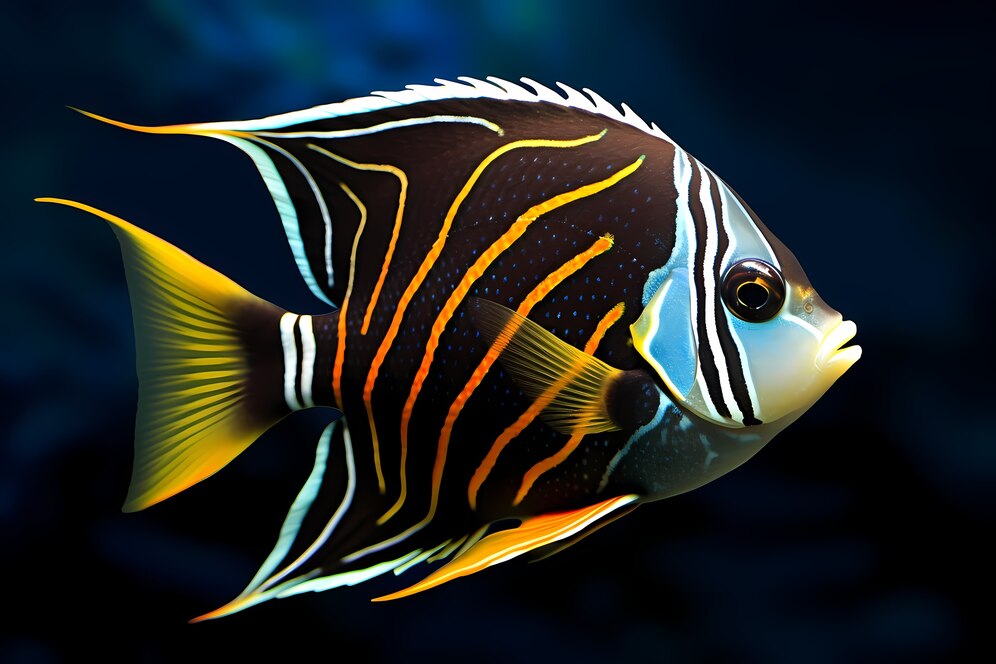
Facts to know about Angelfish
Angelfish are a popular species of fish that are preferred as pets. They make the tank look beautiful with their beauty and colourful appearance. Although angelfish are a common aquarium pet, many fish owners or potential buyers might not be familiar with these exotic-looking swimmers or how to properly care for them.
The vertical stripes, amiable disposition, and other characteristics of this freshwater angelfish make it a popular tank fish. They are members of the Pterophyllum genus. Freshwater angelfish is a kind of fish that needs little care other than a predetermined water temperature range.
If all you know about angelfish is that they have vivid colours, you're probably not the only one. Are you interested in learning more about the different species of angelfish, their temperatures, their statistics, how to care for them, what to feed them, how to breed them, and other topics?
Then check out some interesting facts about angelfish, which we bet even you didn’t know about!
Fact 1: Freshwater angelfish come in a variety of types and colours
Angelfish belong to the cichlid family, which is native to South America. Other well-known species in this category include discuses, parrotfish and Oscars. Standard silver angelfish were the first freshwater angelfish. Breeders have taken advantage of mutations in conventional colouring, though, to produce a wide range of fascinating and lovely variants. The next video shows a breeding pair and their 7-day-old young. One of the most recent is the Philippine Blue Angelfish, which exhibits some blue colouration.
Angelfish come in a variety of hues to satisfy almost every desire thanks to the isolated mutations that have happened in the aquarium environment during the past 50 years. If you're having difficulties picking which colour of angelfish to bring home, you can be confident that it won't have an impact on the temperament or personality of your fish. The disposition of your angelfish will be gentler as long as it doesn't feel crowded in its tank; but, once its hostility is triggered, angelfish tend to stay aggressive, she added.
Fact 2: They are mostly omnivores.
Who or what eats angelfish? Because these omnivores will consume both live items and plants, angelfish require the proper nutrition to grow to their ideal size and maintain good health.
It's typically better to provide flakes or pelleted food designed for angels once a day.
To avoid contaminated sources, give the fish live feedings of recently hatched brine shrimp, bloodworms, and daphnia developed in your cultures.
Additionally, smaller fish in the tank, such as fry and tetras, can be eaten by angelfish.
Fact 3: Angelfish can grow really big in size.
How quickly and how big can an angelfish grow? The average length of an adult angelfish, which is around a year and a half old, is about 6 inches. Although this would be quite uncommon in captivity, they can reach about 10 inches if kept in very big aquariums without being overcrowded.
Fact 4- It Is Best to Keep Them With Their Own Kind.
These fish can coexist with a variety of other tropical species, which is why they are frequently referred to as "community fish." However, they can become aggressive as well.
While this is true when they are young, as they grow older, angels start to become more aggressive and territorial. Because of this, it's typically preferable to keep them in a different tank as adults.
Angelfish can also become hostile towards one another, which typically happens when they are reproducing. Females can be hostile when defending their offspring from other males, while males can battle with other males over partners.
An angelfish "predator" like a betta should never be housed alongside angelfish, just as angelfish may prey on lesser fish.
Fact 5: Male and female angelfish look alike.
Unless the female is ready to reproduce, you normally can't identify a male angel from a female merely by looking at them.
Between their anal and ventral fins, both sexes contain an organ called a papilla.
The female's papilla has a blunt tip and a small enlargement when she becomes gravid, which signifies she is carrying eggs. The male's papilla likewise grows significantly, but it has a sharper tip when he detects a gravid female. This is the primary method of sex discrimination, but it is not perfect.
While one can be sure that any angelfish who lays eggs is a female, it's possible that the other angelfish in the tank who don't become gravid or who don't react to a gravid female are either additional females or males who aren't interested in mating and reproducing.
Conclusion
Angelfish are pretty interesting and fascinating creatures with many unique and interesting characteristics. From their vibrant colours and distinctive shapes to their behaviour and habitat, angelfish continue to captivate people of all ages. Whether you are a seasoned aquarist or just a curious learner, there is always something new to discover about these amazing fish. So, next time you see an angelfish in an aquarium or in the wild, take a moment to appreciate these remarkable creatures and all that they have to offer.
At Intan, we are here to provide you with premium fish feed. Our feed is tailored to meet the specific needs of each species. Every feed can spark positive change and create a future promoting quality, resilience, and well-being. We aim to serve the needs of hobbyists and breeders for the best quality of each species’ unique requirements. To know more about us, check out our Instagram page or find us at our nearest out spot.
We are not just a brand; we are stewards of the underwater world. We believe in the well-being of our friends and their mental health. Understanding and addressing the stressors that affect fish is not just a concept for us, it's a commitment. Through our dedication to research and innovative products, we aim to ensure that fish everywhere can lead happier, healthier lives.
